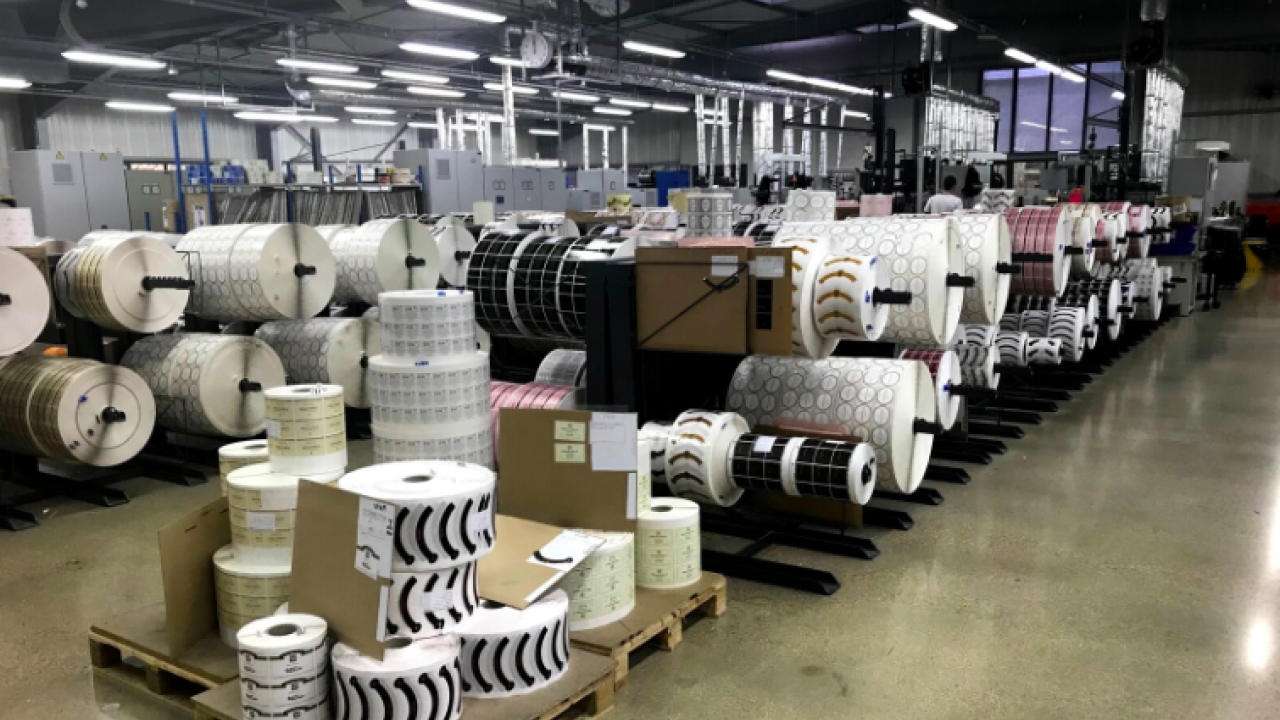Imprimerie Billet sparkles in Champagne label market

The company has remained in family control since it was established 1910 by Joseph Billet, the great-great uncle of the present owner, Arnold Deregnaucourt. During that time, Billet has not been afraid to take a lead in adopting new technologies. In 1937 it brought the first offset press to the region – a project that was delayed because of the war. The company grew as Champagne sales took off in the 1950s, and with it, the taste for innovation. The phasing out of the traditional letterpress presses began with the permanent return of offset in 1968; computer-aided design arrived in 1984. The installation of a Gallus R200 rotary offset press marked the beginning of self-adhesive label converting, which today represents 90 percent of the business. Finally, flexo, for long runs, became an established process in 2006.
‘My work is only complete when the last drop of the bottle is drunk,’ Deregnaucourt says. ‘A Champagne label must fulfil three specific requirements: aesthetic appeal is a given; in addition, there are strict legislative requirements, such as the provision of alcohol content and health warnings. Thirdly, it must meet mechanical demands – performing smoothly on the converting and label application line, so that a perfect laydown is achieved. We work closely with materials suppliers to optimize this. The look of perfection must also provide resistance to moisture, humidity and abrasion because of the exceptional bottle weight.’
Respect
In recent years, Imprimerie Billet has seen many family-owned label printing business disappear. Increasingly, the competition comes from large manufacturing operations.
‘To be successful in this business, it is first and foremost a question of showing respect. We ensure that every Champagne house, no matter the size, receives the same attention to detail and support. The smallest Champagne houses, which often have a less formal approach to order placement, trust us to deliver their order based on just a phone call. On top of this, there can be no compromise on quality. One defect in a batch of 10,000 can result in the loss of a client. And finally, you must be able to deliver creativity cost-efficiently. That means user-friendly workflows and single-pass, combination process printing, where waste is minimized at every opportunity.’
Billet has specified high-value finishing processes on all eight of its existing offset and flexo roll-fed presses since self-adhesive labeling began at the company. Flexo varnishing is essential to protect against abrasion during logistics, due to the bottle heaviness; screen and embossing add impact and tactile qualities to underlying graphics; and foiling meets the demand for metallic effects. Presses feature in-line inspection systems to meet zero-defect requirements.
When it was time to replace an offset machine in 2016, Billet needed an efficient system for delivering shorter production runs, the demand for which is not only driven by the size of the vineyard house alone.
The growing share of worldwide exports, notably to the USA, Mexico, Russia, Canada and New Zealand, compensate for a declining domestic market. This means labels in more languages, with health warnings specific to each country. Additionally, Champagne growers are producing special editions to maintain interest, especially at the higher end of the market.
For Billet, flexo offered excellent returns for the longer runs, but its relatively expensive pre-press, large footprint and thus web path, generally prohibited its use for shorter runs. Offset offered both the outstanding quality with cheaper plates, but the many components, especially in the inking system, can mean higher costs in terms of maintenance and manpower.
Codimag
Deregnaucourt and the team were aware of Codimag, the label press manufacturer located in Bondoufle, south of Paris, and the company’s Aniflo technology. Introduced in 2007, Aniflo is an intermittent technology combining waterless offset ink and plates with a flexo supply system, comprising a chamber doctor blade, anilox roll and rubber roller, which in turn delivers ink to the plate and on to the blanket. Each cylinder has the same diameter, ensuring an exact controllable level of ink is delivered across the web, so exact color is achieved without ghosting. The finely engraved anilox is adapted for the highly viscous waterless ink, and ink density is regulated by a proprietary heat control system.
A semi-rotary system, Aniflo saves tooling costs because one cylinder can be used for all repeat sizes. A dancer system, infeed and outfeed ensure controlled web motion to convert from semi-rotary to stop-and-go motion for flat-bed processes. Billet specified a 340mm-wide 5-color Viva Aniflo press with in-line varnish, rotary and flat-bed foiling, plus semi-rotary screen printing in-line, as well as an automatic waterless offset plate-making system from Presstek. Data processing with the Esko Automation Engine module ensures a fast pre-press workflow.
‘Codimag’s Aniflo combines the high definition of offset and the easy operation of flexo,’ Deregnaucourt says. ‘Though a new concept, Aniflo is based on our two core processes. Our operators have many years’ experience of anilox-based printing, so there was a relatively low training requirement. Thanks also to its straightforward pre-press workflow, we were able to integrate it smoothly into our operations.’
The Viva Aniflo at Billet is being used for sophisticated labels in production runs of between 1,000 and 50,000. Its simplicity and relatively short web path means color targets can be achieved with minimal material waste, especially in the start-up phase.
‘In flexo, you get immediate results but due to the web-path, 30 meters of waste at the beginning, while conventional offset takes time to regulate the color because of the opening of the inking systems,’ says Deregnaucourt. ‘However, with Aniflo, it takes just a few minutes of makeready time to set the temperature and the results are immediate.’
A dedicated chamber and anilox washing zone near-line allows Expanding Grower Champagne sector highlights demand for short print runs The flexibility to supply short as well as longer runs is increasingly important in the Champagne market. Besides the 100 or so big globally recognized ‘Grand Marque’ Champagne Houses, there are approximately 5,000 others that produce their own wines, known as Grower Champagnes, using grapes exclusively from their own estate. Sourced from a single vineyard, or closely located vineyards surrounding a village, they are identified by the letters ‘RM’ (Récoltant-Manipulant) on the wine label. Recently, demand for Grower Champagnes – mostly available in relatively small quantities – has increased, as independent producers gain recognition for their efforts to enhance the quality, complexity of palette and diversity of their produce. Récoltant-Manipulants seeks to cultivate a distinct identity that primarily reflects quality, heritage and values of the grower, rather than luxury and prestige associated with a Grande Marque Champagne. One example is Champagne Le Gallais, of Boursault, on the south bank of the Marne, just downstream from Èpernay. Owners Charlotte and Hervé Le Gallais produce 25,000 bottles annually from four hectares of land. They produce five Cuvées, of which Cuvée du Manoir Brut accounts for about 80 percent of sales. Others are Brut Naturel, Rosé and Blanc des Blancs varieties, plus a special edition Millésime 2008. Each Cuvée is aged for between three and ten years. Le Gallais introduces special editions occasionally, to enhance market interest, by experimenting with different combinations of grapes, ages and cultivation areas. Sixty percent of sales are to restaurants, including those with Michelin stars; other business comes directly from consumers via the website, and corporate clients. Le Gallais recently revamped its wine labels, with a simpler design including a bolder logo. ‘I simply wanted our labeling to be faithful to our way of making and living this Champagne – straight and pure, with a sense of depth resulting from the ageing, and of tradition,’ Charlotte Le Gallais says. Le Gallais relies on Imprimerie Billet for its supply labels, choosing the company for its responsiveness, especially when advising on technical matters relating to colors, graphics and paper choice. It places one order annually for all its wines, in quantities from 1,000 to 20,000. These are applied with an ID Concept machine, shortly before dispatch. For more news and features on Codimag, go to www.labelsandlabeling.com/search/site/Codimag immediate changeovers between jobs. Generally, lead-times at Billet are between four and five weeks. Deregnaucourt aims to reduce these nearer to three – and the speed of the Aniflo workflow, will help towards this aim.
Undoubtedly, innovation will be crucial to the Champagne region’s future success, particularly in addressing climate change. Recent examples include lighter 830g bottles that reduce the carbon footprint by 15 percent and new grapes with more resistance to higher temperatures and disease.
The same can be said of the label, given its vital role in the branding of Champagne, not least in the face of growing competition from other sparkling wines. In a market that is generally stable, Billet’s business is growing. Deregnaucourt concludes: ‘Success in this business centers around outstanding quality, the imagination to create a variety of sophisticated designs efficiently, and assuring the service to match. The addition of Codimag’s Viva Aniflo press to our operation means we are well-placed to continue this success in a highly competitive market.’
Stay up to date
Subscribe to the free Label News newsletter and receive the latest content every week. We'll never share your email address.


